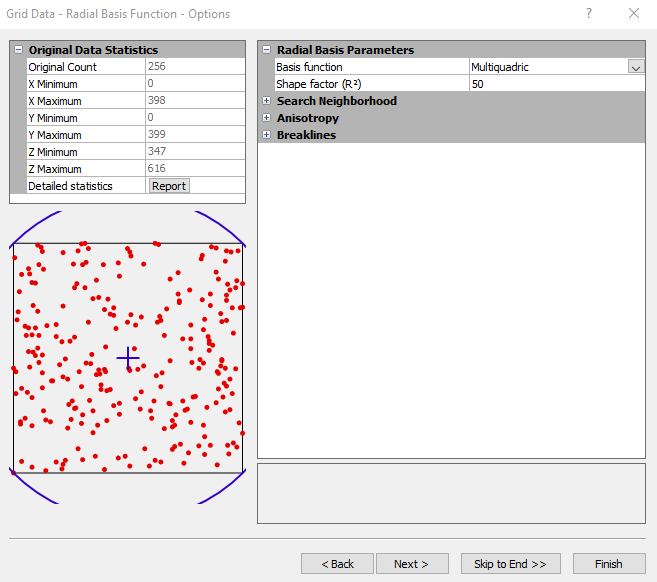Radial Basis Function
Radial Basis Function interpolation is a diverse group of data interpolation methods. In terms of the ability to fit your data and to produce a smooth surface, the Multiquadric method is considered by many to be the best. All of the Radial Basis Function methods are exact interpolators, so they attempt to honor your data. You can introduce a shaping factor to all the methods in an attempt to produce a smoother surface. Regardless of the R2 value, the Radial Basis Function is an exact interpolator.
Radial Basis Function Options Dialog
In the Grid Data dialog, specify Radial Basis Function as the Gridding Method and click the Next button to open the Grid Data Radial Basis Function Options dialog.
|
|
|
Set the type of Basis Function and Anisotropy in the Grid Data Radial Basis Function Options dialog. |
Basis Function
Specify the function type from the Basis Function list. The basis kernel functions are analogous to variograms in Kriging. The basis kernel functions define the optimal set of weights to apply to the data points when interpolating a grid node. The available basis kernel functions are listed in the Basis Function list in the Grid Data Radial Basis Function Options dialog.
|
Type |
Equation |
|
Inverse Multiquadric |
|
|
|
|
|
Multiquadric |
|
|
|
|
|
|
where:
|
h |
= the anisotropically rescaled, relative distance from the point to the node |
|
R2 |
= the shaping factor specified by the user |
R2 Parameter
The default value for R2 in the Radial Basis Function gridding algorithm is calculated as follows:
(length of diagonal of the data extent)2 / (25 * number of data points)
Search Neighborhood
Specify search rules. For more information about search rules, see Search.
Anisotropy
Set anisotropy settings if needed. For more information about anisotropy options, see Anisotropy.
Breaklines
The Breaklines section is used to add breaklines to the gridding process. Faults are not supported with Radial Basis Function.
References
A concise and readable introduction to Radial Basis Function interpolation can be found in Carlson and Foley (1991a). Given the clarity of presentation and the numerous examples, Hardy (1990) provides an excellent overview of the method, although this paper focuses exclusively on the special case of multiquadrics.
Carlson, R.E., and Foley, T.A. (1991a), Radial Basis Interpolation Methods on Track Data, Lawrence Livermore National Laboratory, UCRL-JC-1074238. DOI: 10.2172/5323933
Carlson, R. E., and Foley, T. A. (1991b), The Parameter R2 in Multiquadric Interpolation, Computers Math. Applic, v. 21, n. 9, p. 29-42. DOI: 10.1016/0898-1221(91)90101-7
Franke, R. (1982), Scattered Data Interpolation: Test of Some Methods, Mathematics of Computations, v. 33, n. 157, p. 181-200. DOI: 10.2307/2007011
Hardy, R. L. (1990), Theory and Applications of the Multiquadric-BiHarmonic Method, Computers Math. Applic, v. 19, n. 8/9, p. 163-208. DOI: 10.1016/0898-1221(90)90112-9
Powell, M.J.D. (1990), The Theory of Radial Basis Function Approximation in 1990, University of Cambridge Numerical Analysis Reports, DAMTP 1990/NA11. DOI: 10.17863/CAM.73801
